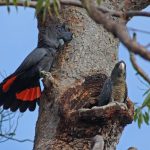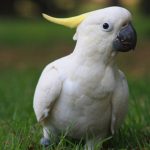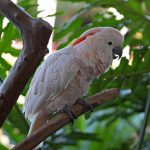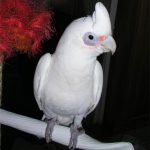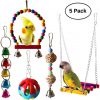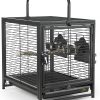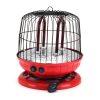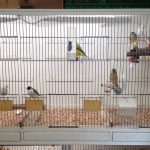Cockatoos
Cockatoos are types of parrots, specifically, 21 species hailing from the Cacatuidae family. These birds are among the most sought-after pets in aviculture, though meeting their needs could be a little difficult. Of all the cockatoo species, the cockatiel is most common as pet due to its relative ease of maintenance.
List of the Types of Cockatoos
- Galah (Rose-breasted Cockatoo)
- White Cockatoo (Umbrella Cockatoo)
- Yellow Crested Cockatoo
- Cockatiel
- Sulphur Crested Cockatoo
- Cacatua
- Major Mitchell’s Cockatoo
- Salmon-crested Cockatoo (Moluccan Cockatoo)
- Red-tailed Black Cockatoo
- Tanimbar Corella (Goffin’s Cockatoo)
- Carnaby’s Black Cockatoo
- Glossy Black Cockatoo
- Baudin’s Black Cockatoo
- Glossy Black Cockatoo
- Citron-crested Cockatoo
- Yellow-tailed Black Cockatoo
- Palm Cockatoo (Black Palm Cockatoo)
- Slender-billed Cockatoos
- Eleonora Cockatoo (Medium Sulphur-crested Cockatoo)
- Gang-gang Cockatoo
- Triton Cockatoo
- Bare-eyed Cockatoo
What Does a Cockatoo Look Like
Cockatoos are generally bigger than parrots except for the cockatiel, considered the smallest among its group. They are characterized by a colorful crest, recursive (prominent even when not fanned), or recumbent (not seen unless it is fanned) that can be raised or brought down at the bird’s will. They also have curved heavy bills and a plumage of grey, black, and white, which is less colorful than the other parrot species.

Cockatoo
Distribution and Habitat
They are not as widely distributed as the other species of parrots, restricted to the regions of Australasia, the Philippines, and Indonesia. In fact, of all the 21 species, 11 of them are just found in Australia in the wild, 3 are found in both Australia as well as New Guinea, while 7 of them thrive in Indonesia, the Philippines as well as the islands of Solomon and Papua New Guinea of Oceania.
Lifespan of Cockatoos
Most cockatoo species live between 40 and 60 years on average when they are given proper care and are not prey to any catfights. Cockatiels are the most short-lived cockatoo species surviving for only 10 to 15 years.
Breeding and Mating
Being monogamous, pair bonds between them are known to last for long. They mostly prefer building their nests at 7 to 8 feet above the ground near food and water sources, with holes in trees being their favorite spot. The clutch size varies from one species to the other, with larger ones like the palm cockatoo laying one egg on average while the smaller ones lay two to eight eggs. The incubation period also differs, being about 20 days for the smaller varieties and approximately 29 days for the larger species like Carnaby’s black cockatoo.
Cockatoos as Pets
Housing and Cage Requirements
Cage Size
Cockatoos are renowned for their intelligence. Hence they need a large cage, not just for physical comfort but also for mental satisfaction, so that they may entertain themselves by exploring and playing around. When choosing a cage, always go for a durable one, which is easy to maintain and is either square or rectangular, as they provide greater scope for movement than round ones.
Small-sized birds like the Bare Eyed or Goffin’s cockatoo need a cage with a depth of 24 to 26 inches, width of 36 to 38 inches, and height of 60 to 62 inches.
Medium-sized varieties, including the Eleanor and Citron cockatoo, require housing with a depth of 29 inches, width of 46 inches, and height of 72 inches. Large species like the Moluccan and Umbrella cockatoo need cages being 30 to 36 inches in depth, 48 inches in width, and 72 inches in height.
Ideal Temperature Range
Most species of healthy cockatoos would thrive well at about 80 to 90 °F; however, older birds need to stay at a lower temperature.
Accessories
Keep at least two perches inside the spacious cage with a length and diameter of 9 inches and 1 inch, respectively. Ropes, swings, tree branches, and chew toys should be put inside the cage for your bird to entertain itself. Playpens can also be provided outside the cage to give your pet sufficient space to roam about when it steps out of its enclosure. You can buy it from pet stores or even make it at home by using perches, swings, toys, ladders, and other interesting things that would attract your pet.
Things to Remember
- Place the perch in such a way that you can have access to it from outside. Also, avoid placing it on the food or water bowl.
- Fill a large ceramic bowl with water and place it at the bottom of the cage to help your bird bathe whenever it wishes.
- Change the water on a regular basis and keep the cage clean for better hygiene.
Behavioral and Temperamental Traits
The Cockatoos have an exuberant and affectionate behavior, bonding intimately with their owners. They require most of their master’s time, the lack of which could make them bored and exhibit destructive behaviors like screeching, biting, screaming, head banging, and feather plucking. Since they need to be pampered, always they may not be a good choice for kids, and if disturbed or pestered in any way, they could even resort to biting, which could be quite painful because of their powerful beaks. People keen on keeping their cats and birds together make sure that both are introduced to each other, or else your cockatoo could get aggressive and injure your feline by biting it.
Are they intelligent: Cockatoos are renowned for their intelligence and smartness, and recent findings conducted by the University of Vienna, Oxford University, and Max Planck Institute on ten Goffin’s cockatoo species deduced their ability in solving complicated mechanical puzzles and even concluded that they had a greater skill of object permanence (remembering and finding an object even when it is not present) than apes and even a four-year-old kid.
Do they talk: Cockatoos possess the innate ability to mimic any sounds and even the words you speak daily. To increase its vocabulary stock, you need to speak to it regularly but slowly, clearly, and distinctly so that it can understand all that you are saying.
Video: A Cockatoo Singing
Dietary Needs
Give your cockatoo a balanced and nutritious diet comprising vegetables and seeds and cooked rice, fruits, proteins, and nuts, in measured quantities. Ensure your bird is not just eating seeds; instead, you should take the initiative in introducing pellets to your bird’s food which should comprise 75 to 80% of your diet. Vegetables and fruits, on the other hand, should make for 20 to 25% of its food chart.
Health Problems
Some of the health problems that your cockatoo may face include Psittacine beak and feather disease (highly contagious), obesity problems, bumblefoot (marked by swelling and lameness), obesity problems and fatty tumors, and herpes infections. Cockatoos are also interested in eating chicken, and most of them indulge in crushing the bone and eating the bone marrow filled with protein.
Interesting Facts
- References to cockatoos can be found in literature as early as the 13th century in ‘De arte venandi cum avibus’ by Frederick II.
- They appeared in various television shows and films like Baretta (detective series) and Serpico (a 1973 film).
- The World Parrot Trust uses the palm cockatoo, renowned for its unique beak and face color, as its symbol.
- BirdLife International and IUCN mention seven of the cockatoo species to be vulnerable, out of which the yellow-crested and red-vented cockatoo are at risk of being critically endangered.
Price
The cost of a cockatoo varies on the basis of the species and color, though the average price varies between $500 and $1200. The cost of an umbrella cockatoo varies from $1000 to $3000.









